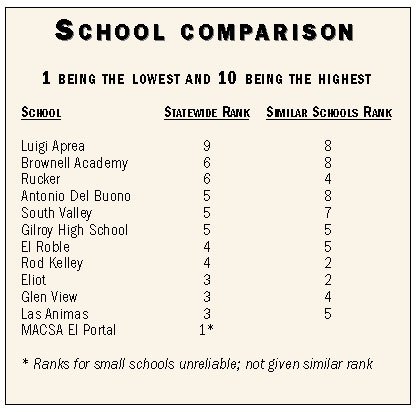GILROY
– More Gilroy schools are outperforming similar institutions as
well as schools statewide, based on newly released data taken from
scores on last year’s standardized tests.
GILROY – More Gilroy schools are outperforming similar institutions as well as schools statewide, based on newly released data taken from scores on last year’s standardized tests.
For the first time, three out of 11 schools in Gilroy Unified School District rank in the top 20 percent of like schools. However, there is still room for improvement: four schools still rank in the bottom 40 percent of similar schools. Five GUSD schools lag behind more than half of all schools in the state.
Two schools fell from 2002 to 2003 when compared to schools with similar characteristics. However, GUSD schools in general improved their placement among comparable schools for the third year in a row.
“What it tells me is, in order to make improvements … it takes an extensive effort because most schools in the state are also making improvements,” said Superintendent Edwin Diaz, who added that schools are mandated to better their scores each year. “So not only do you have to improve just to make the status quo, but you have to have some effort to improve your rankings.”
The rankings, released this morning by the California Department of Education, show how Gilroy schools stack up against schools with similar demographics, based on student performance. They are taken from newly calculated Academic Performance Index (API) scores and compare schools to 100 others with similar characteristics, such as ethnicity, economic status and English language proficiency among students.
In all, six GUSD schools improved in their similar schools rankings, two fell, one stayed the same and two were not ranked in 2002.
“While we’re pleased with that, you always want to see that continuous improvement, so there’s always room to grow,” said Esther Corral-Carlson, director of student assessment. “While that may have been an improvement … we would like to be a 9 or a 10 when being compared to your similar schools.”
The results have a tendency to fluctuate wildly from year to year but highlight areas of steady improvement within the district.
“Over the last few years, they’ve all had their turn in making progress,” Diaz said.
For the third year in a row, two of Gilroy’s middle schools continued their trend of improvement when compared to similar schools. Brownell Academy Middle School beat out 80 percent of similar schools last year, while South Valley Middle School outperformed 70 percent. Both schools moved up one level in their ranking among similar schools. Brownell scored an 8 and South Valley a 7 on the similar schools ranking.
Ascencion Solorsano Middle School does not have an API or similar schools ranking because scores are based on tests taken in spring 2003, before the school opened last fall.
Several elementary schools made significant jumps compared to schools just like them. When measured up to its counterparts, Antonio Del Buono boasted the biggest leap in the district, improving its ranking from the 40th percentile to the 80th percentile.
Luigi Aprea, historically the district’s highest-achieving school, was the third GUSD school to score in the 80th percentile among similar schools this year, while scoring in the 90th percentile when compared with all elementary schools in the state, the highest in the district.
The base 2003 API scores, also released today, will set the standard for improvement in the 2003-04 API scores to be released this fall.
The “growth” API released each fall shows how much a school improved over the previous year’s test scores. In March, the API is recalculated to compare schools and create new improvement goals for upcoming testing.
Luigi Aprea did not receive a base API or similar schools rank in 2002 because of a testing irregularity that invalidated test results. Its API for 2003 is 837, making it the only GUSD school to pass the state’s benchmark of 800.
“The scale does go to 1,000,” Corral-Carlson said. “There’s still opportunity for them as a school to make some improvements.”
When compared to all schools in California, Gilroy schools did not stack up quite as well as when compared to similar schools, although there was improvement over results from 2002.
In that year, two GUSD schools ranked in the bottom 20 percent while Ruckers was the only school to outrank 60 percent of schools statewide. In 2003, three schools scored in the 60th percentile or above compared to all others in the state and none were below the 30th percentile.
The similar schools rank is often taken with a grain of salt.
Gilroy High School, for example, improved its API 38 points from spring 2002 to spring 2003, climbing into the 50th percentile of schools statewide but dropping two levels into the 50th percentile of similar schools.
“I can’t explain that,” Diaz said, laughing.
Principal Bob Bravo, who has yet to examine GHS’s group of 100 similar schools, said it’s possible the school was put into a more difficult grouping.
“In the similar schools grouping, 75 percent of those are new schools,” he said. “Just examining it, I’m not sure yet why the list looks so different.”
The improvement in state ranking is more significant, Bravo said.
“That has meaning because that’s a more constant,” he said. “Because it’s out of all schools in the state, they’re not choosing who you’re going to be ‘similar’ to.”
The similar schools rank for Rucker Elementary School has held steady at the 40th percentile for three years now, while its state rank moved from the 50th to the 60th percentile in 2002 and held steady last year. However, in that time, its API improved by more than 60 points.
“The thing that I’m paying more attention to is the API, because that’s where we get our numbers, and that’s what tells us whether as a whole our scores have increased or decreased,” Rucker Principal Steve Gilbert said. “And that’s where I’m seeing, as a whole, consistent growth.”
He can use today’s similar schools rankings to look at how others are bettering their scores, he said.
“(The API) doesn’t give me that breakdown that I’d really like to look at in terms of, ‘What did we do really well, and what do we need to work on?’ ” Gilbert said.
Also, because the API scores are a year old and schools are again gearing up to take this year’s standardized tests, the rankings will have little effect on curricular decisions, he said.
Diaz said the district’s steady growth can be attributed to a number of factors.
“I think it’s having a clear focus on improving student performance. I think it’s the effectiveness of staff development and using student performance to make adjustments in the classroom based on student academic needs.”













